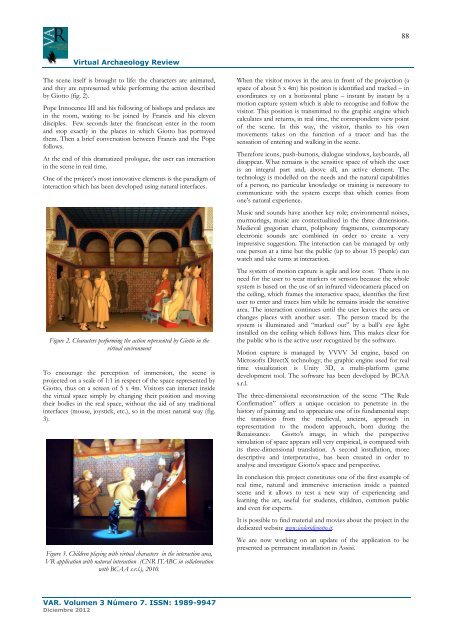Virtual Museums
Virtual Museums
Virtual Museums
You also want an ePaper? Increase the reach of your titles
YUMPU automatically turns print PDFs into web optimized ePapers that Google loves.
<strong>Virtual</strong> Archaeology Review<br />
The scene itself is brought to life: the characters are animated,<br />
and they are represented while performing the action described<br />
by Giotto (fig. 2).<br />
Pope Innocence III and his following of bishops and prelates are<br />
in the room, waiting to be joined by Francis and his eleven<br />
disciples. Few seconds later the franciscan enter in the room<br />
and stop exactly in the places in which Giotto has portrayed<br />
them. Then a brief conversation between Francis and the Pope<br />
follows.<br />
At the end of this dramatized prologue, the user can interaction<br />
in the scene in real time.<br />
One of the project’s most innovative elements is the paradigm of<br />
interaction which has been developed using natural interfaces.<br />
Figure 2. Characters performing the action represented by Giotto in the<br />
virtual environment<br />
To encourage the perception of immersion, the scene is<br />
projected on a scale of 1:1 in respect of the space represented by<br />
Giotto, thus on a screen of 5 x 4m. Visitors can interact inside<br />
the virtual space simply by changing their position and moving<br />
their bodies in the real space, without the aid of any traditional<br />
interfaces (mouse, joystick, etc.), so in the most natural way (fig.<br />
3).<br />
Figure 3. Children playing with virtual characters in the interaction area,<br />
VR application with natural interaction (CNR ITABC in collaboration<br />
with BCAA s.r.l.), 2010.<br />
VAR. Volumen 3 Número 7. ISSN: 1989-9947<br />
Diciembre 2012<br />
When the visitor moves in the area in front of the projection (a<br />
space of about 5 x 4m) his position is identified and tracked – in<br />
coordinates xy on a horizontal plane – instant by instant by a<br />
motion capture system which is able to recognise and follow the<br />
visitor. This position is transmitted to the graphic engine which<br />
calculates and returns, in real time, the correspondent view point<br />
of the scene. In this way, the visitor, thanks to his own<br />
movements takes on the function of a tracer and has the<br />
sensation of entering and walking in the scene.<br />
Therefore icons, push-buttons, dialogue windows, keyboards, all<br />
disappear. What remains is the sensitive space of which the user<br />
is an integral part and, above all, an active element. The<br />
technology is modelled on the needs and the natural capabilities<br />
of a person, no particular knowledge or training is necessary to<br />
communicate with the system except that which comes from<br />
one’s natural experience.<br />
Music and sounds have another key role; environmental noises,<br />
murmurings, music are contextualized in the three dimensions.<br />
Medieval gregorian chant, poliphony fragments, contemporary<br />
electronic sounds are combined in order to create a very<br />
impressive suggestion. The interaction can be managed by only<br />
one person at a time but the public (up to about 15 people) can<br />
watch and take turns at interaction.<br />
The system of motion capture is agile and low cost. There is no<br />
need for the user to wear markers or sensors because the whole<br />
system is based on the use of an infrared videocamera placed on<br />
the ceiling, which frames the interactive space, identifies the first<br />
user to enter and traces him while he remains inside the sensitive<br />
area. The interaction continues until the user leaves the area or<br />
changes places with another user. The person traced by the<br />
system is illuminated and “marked out” by a bull’s eye light<br />
installed on the ceiling which follows him. This makes clear for<br />
the public who is the active user recognized by the software.<br />
Motion capture is managed by VVVV 3d engine, based on<br />
Microsofts DirectX technology; the graphic engine used for real<br />
time visualization is Unity 3D, a multi-platform game<br />
development tool. The software has been developed by BCAA<br />
s.r.l.<br />
The three-dimensional reconstruction of the scene “The Rule<br />
Confirmation” offers a unique occasion to penetrate in the<br />
history of painting and to appreciate one of its fundamental step:<br />
the transition from the medieval, ancient, approach in<br />
representation to the modern approach, born during the<br />
Renaissance. Giotto's image, in which the perspective<br />
simulation of space appears still very empirical, is compared with<br />
its three-dimensional translation. A second installation, more<br />
descriptive and interpretative, has been created in order to<br />
analyse and investigate Giotto's space and perspective.<br />
In conclusion this project constitutes one of the first example of<br />
real time, natural and immersive interaction inside a painted<br />
scene and it allows to test a new way of experiencing and<br />
learning the art, useful for students, children, common public<br />
and even for experts.<br />
It is possible to find material and movies about the project in the<br />
dedicated website www.icoloridigiotto.it.<br />
We are now working on an update of the application to be<br />
presented as permanent installation in Assisi.<br />
88


